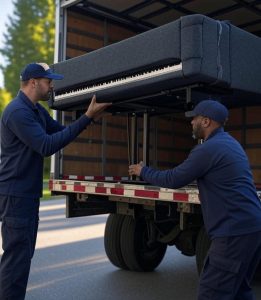Moving the Music: How to Relocate Instruments Without Missing a Beat
Musical instruments are highly sensitive to movement, temperature, and pressure. A slight mishandling can affect sound quality or even cause irreversible damage. Whether it’s a vintage upright piano, an electric guitar, or delicate recording gear, each item demands special attention when it’s time to move.
Professional movers familiar with musical equipment can make all the difference. Working with the best NYC to Greenwich CT movers ensures not just a smooth relocation, but also peace of mind knowing your instruments are treated with expert care. These movers have experience handling high-value gear, heavy pianos, and sensitive audio components.
Protecting Pianos: The Giants of the Music World
 Upright and grand pianos are among the most challenging instruments to relocate. Their size, weight, and inner complexity make them vulnerable during transport. Keys, pedals, strings, and soundboards must all remain intact and undisturbed. Even slight jostling can ruin alignment.
Upright and grand pianos are among the most challenging instruments to relocate. Their size, weight, and inner complexity make them vulnerable during transport. Keys, pedals, strings, and soundboards must all remain intact and undisturbed. Even slight jostling can ruin alignment.
Here’s what professional movers typically do to protect your piano:
- Use of padded moving blankets and shrink wrap to protect the exterior finish
- Secure the lid and pedal mechanisms
- Use of a piano skid board and heavy-duty straps
- Loading with specialized dollies and lift gates
Once moved, allow your piano to acclimate for a few days before tuning. Temperature and humidity shifts can slightly alter the tension in the strings, requiring adjustment for proper sound.
Guitars and Stringed Instruments: Handle With Heart
Guitars are fragile in more ways than one. Their wooden bodies can crack under sudden impact, and strings or necks can warp with heat or pressure. Whether it’s an acoustic, electric, or bass guitar, extra care is needed.
Simple tips to keep them safe:
- Loosen the strings before packing
- Place the guitar in a hard-shell case with padding
- Add bubble wrap inside the case to limit movement
- Keep them away from direct sunlight or extreme temperatures
Movers with experience will treat your guitar like a piece of fine art. And that’s exactly how it should be handled—carefully, gently, and with respect for its craftsmanship.
Studio Equipment: Keeping Your Sound Untouched
Recording equipment, speakers, microphones, and mixing boards are the heart of a modern studio. These tools are expensive, precision-built, and sometimes customized. They must be kept clean, static-free, and secure during a move.
Here’s how to safely move studio gear:
- Label all wires and cables before disconnecting
- Use original packaging when possible for gear like mixers or audio interfaces
- Wrap smaller items in anti-static bubble wrap
- Use padded containers for monitors and speakers
Even minor bumps can throw off calibration. Make sure everything is placed tightly in boxes with foam or soft materials to cushion any movement in transit.
After protecting and boxing your mixer, microphones, and monitors, consider professional advice for ensuring they remain perfectly calibrated on arrival. For guidance on setup and studio rigging tips, check out the “Gear Up!” section on imacliche.com, which covers technical details that can preserve your sound quality during and after transit.
Choosing Movers That Understand Musicians
General moving companies may not know how to treat musical instruments with the caution they require. That’s why working with movers who specialize in fragile, valuable, or custom-built items is so important.
Ask the right questions before hiring:
- Do they have experience with musical equipment?
- Are they insured specifically for high-value gear?
- Can they provide references from musicians or studios?
A professional mover should give you confidence, not concern. From the first conversation to the final unload, your instruments should feel like they’re in the hands of someone who gets it.
Final Setup and Sound Check
After the move, allow your instruments time to settle into their new space. Let pianos rest before tuning. Reconnect studio gear slowly, testing connections and audio quality one step at a time.
If you’re unsure about reassembly or fine-tuning, call in an expert. Piano tuners, luthiers, and sound engineers can make sure everything is performing just as it did before the move, if not better.
Keep the Music Playing
Relocating your instruments doesn’t have to be a stressful experience. With proper packing, experienced movers, and a bit of patience, your music can travel as smoothly as a favorite song. Whether you’re moving across boroughs or state lines, don’t let the transition hit a wrong note. Your sound matters. Protect it every step of the way.
Read More Moving the Music: How to Relocate Instruments Without Missing a Beat